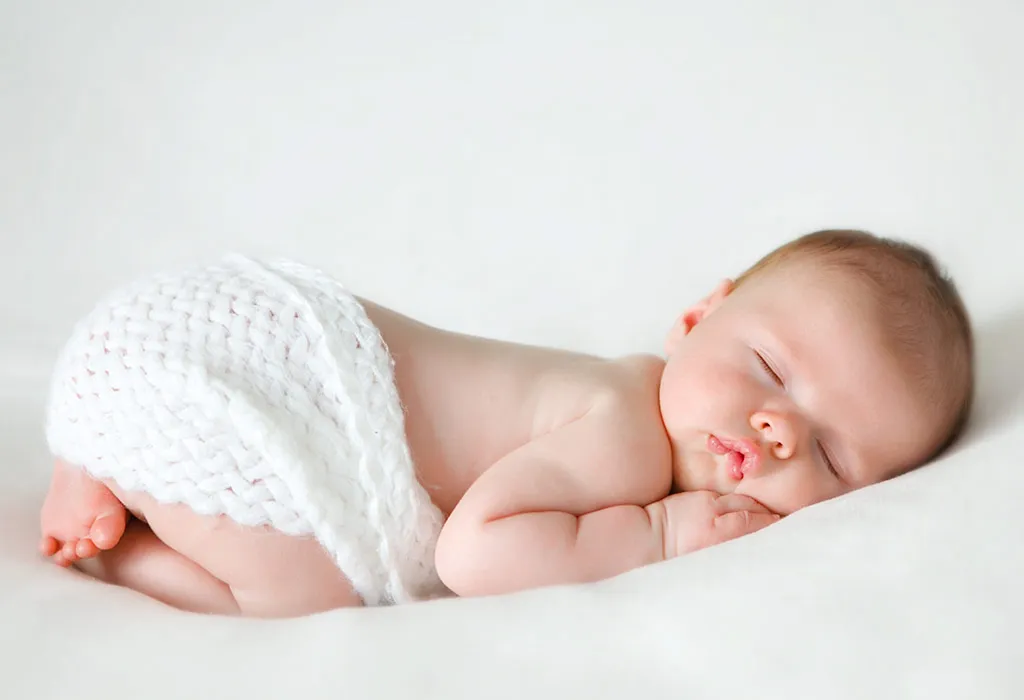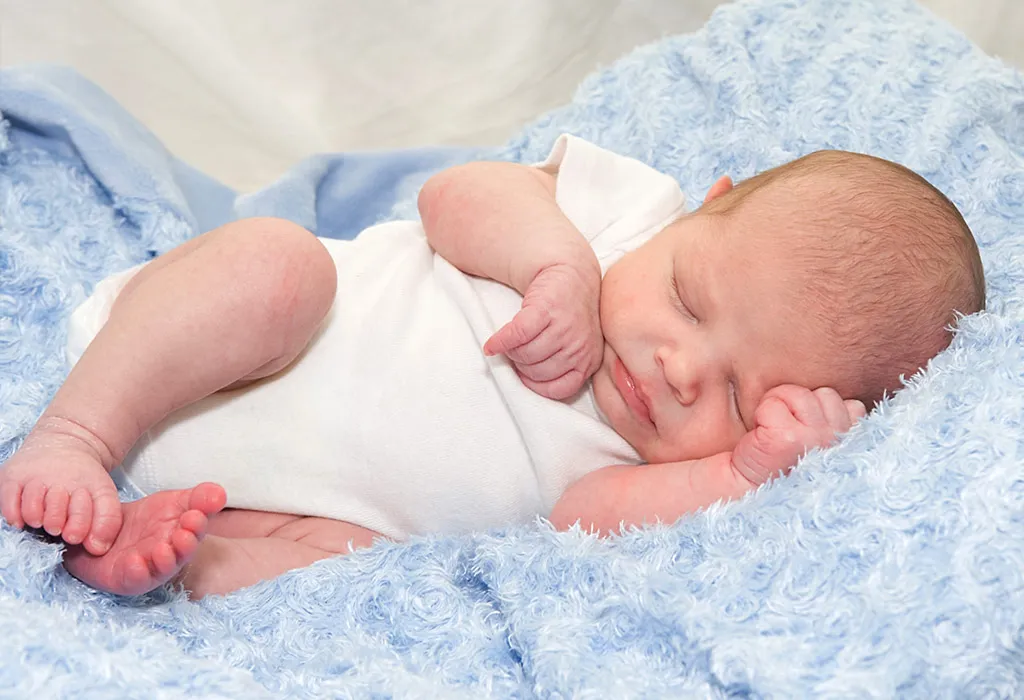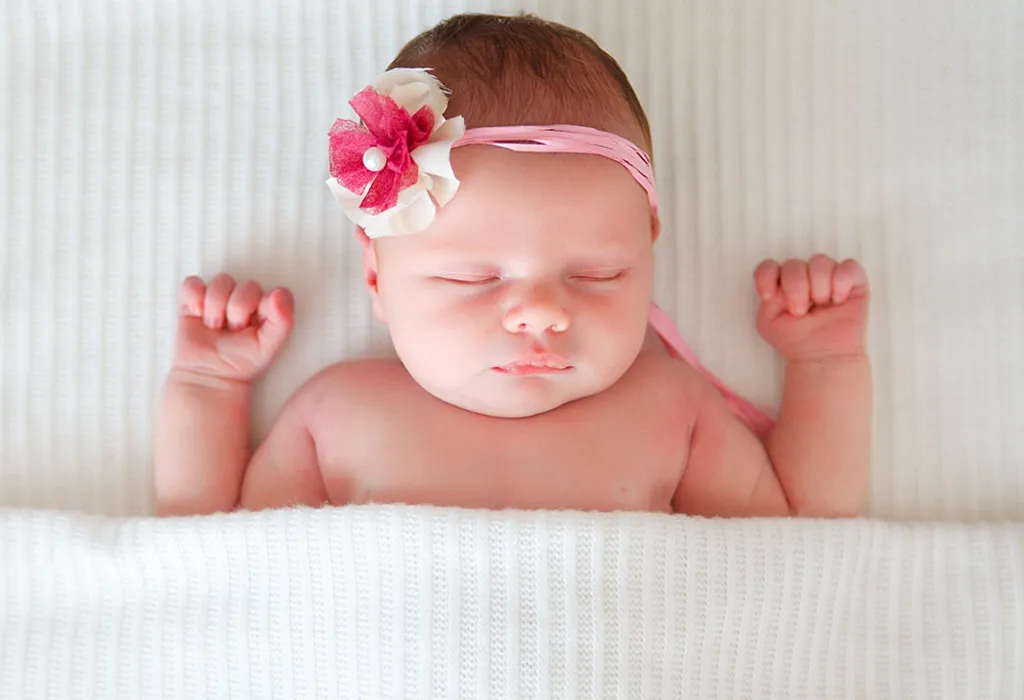Babies sleep a lot, and ensuring they sleep in a safe position is very important because wrong sleeping positions in infants can sometimes lead to SIDS (sudden infant death syndrome). SIDS in children is caused due to suffocation or strangulation. If you have an infant at home, it is essential that you know everything about the ideal sleeping positions for babies and how certain sleeping positions can cause sudden deaths in newborns.
Which Sleeping Positions Increase the Risk of Sudden Unexpected Death in Infancy (SUDI)?
You may have observed infants sleeping in various positions. Some of these sleeping positions increase the risk of sudden unexpected death in infancy (SUDI). SUDI is a broad term that encompasses all sudden deaths in infants, including SIDS, which is generally caused due to suffocation in a newborn. Sleeping on the chest/stomach is one of the most dangerous positions for infants. Let’s take a look at some more sleeping positions that increase the risk of SUDI.
1. Sleep-On-Stomach Position

Risk Involved
The sleep-on-stomach position for babies is highly unsafe for the following reasons:
- This position may put some pressure on the baby’s jaws and block the airways, making it difficult for the baby to breathe.
- Sleeping on the stomach makes the baby lie with his face very close to the sheet, making him breathe the same air. This may result in breathing in recycled air which is low in oxygen.
- Sleeping on the stomach on a very soft mattress may cause suffocation in babies. The risk of rebreathing the exhaled air is higher while lying on a soft mattress because of the baby’s face slacks deeper into the soft fabric of the mattress. This might block the baby’s airways from all sides.
- Also, because the nose is placed very close to the mattress in this position, the baby ends up breathing in the microbes present in the sheet covering the mattress, and this may lead to allergies.
Sometimes, in case of certain medical conditions, doctors may advise parents to put the baby to the sleep-on-stomach position. Usually, children with gastroesophageal reflux or certain upper-airway malformations like Pierre Robin Syndrome are advised to sleep in this position, but it may not work. Hence, it is advisable to consult the physician properly before putting the baby to sleep on his stomach.
2. Sleep-On-The-Side Position

Sleeping on the side is not a recommended infant sleeping position, as infants tend to eventually roll-on to their tummy while asleep, and this increases the risk of SIDS due to one of the reasons mentioned above.
So then which sleeping position is good for your baby? Well, the only option remaining now is the sleep-on-back position. Let’s take a closer look at it.
Safe Sleeping Position for Infants
The sleep-on-back position is the safest and the best sleeping position for infants. It is the most suggested sleeping position for babies as it keeps the airways open and has minimal risks of suffocation. The US NICHD (National Institute of Child Health and Human Development) recommends the sleep-on-back position for short naps as well as for sound sleep throughout the night in babies.

However, this sleeping position also has some risks involved. Here are some of them:
Risks Involved in the Sleep-On-Back Position
Children lying in the sleep-on-back position for a long time may suffer from ‘positional plagiocephaly’, a case of flattened head or the baby may also suffer from ‘brachycephaly’, a case of flattened back. But, these are temporary conditions that normalise as soon as the baby turns one. Having said that, there are some techniques that you can use to avoid these conditions altogether –
- More tummy time when the baby is awake.
- Turning the baby on the sides while he is not asleep.
- Reducing the time spent in carriers or car-seaters.
These techniques allow the baby to lie down in different positions instead of lying down on the back.
There are a few more things you can follow to ensure your baby sleeps safely. The tips provided below will help you manage or correct your baby’s sleep positions.
Tips for Safe Baby Sleep
Here are some tips to reduce the risks of SUDI and ensure that your baby has a sound sleep.
1. Use a Firm Mattress for the Baby’s Bed
Many parents make the mistake of choosing soft mattresses for babies. This must be avoided. Babies must be put to sleep in firm beds. Also, the use of bumper pads, pillows, or soft-toys inside the baby’s crib must be avoided as it may accidentally cover the baby’s head.
2. Avoid Quilts and Comforters
Avoid using quilts and comforters on top of the mattress to make the bedding soft. It may make the baby sink under the bedding and increase risks of suffocation. Just place a clean, fitting mattress inside the crib and cover it with a clean bed sheet, and that is enough for your baby to have a comfortable sleep.
3. Tug the Blanket Properly
Blankets should only cover the babies up to the chest. The arms must be kept outside the blanket to ensure that the blanket does not get rolled up to the head and suffocate the baby. You may use sleeping bags with a fitted neck and armholes that are easily available in the market and are highly recommended. They are safe to use and keep the baby warm too.
4. Night Clothes Should be Light Clothes
It’s important to dress the baby in light clothes for a good night’s sleep. Ensure the clothes are no too tight and not too loose.
5. Keep the Room Cool at Night
It is also suggested that children should be put to sleep in a cool environment, preferably 20 degrees centigrade.
6. Use Pacifiers If Necessary
The American Academy of Paediatrics (AAP) suggests that infants can be given pacifiers just before sleep-time. However, forcing newborns to use pacifiers is not advisable. Wait till they are about 4 weeks old before you even try it.
7. Avoid Co-Sleeping With the Baby
Infants sharing beds with parents, siblings or even with his twin is not advisable. Co-sleeping with the baby can increase the chances of SIDS. When in sleep, your arms or breast or your clothes may accidentally cover your baby’s face and end up suffocating the baby. In India, co-sleeping with the baby is a common norm as it is easy to feed the baby at night. But now you know why it must be avoided!
8. Share the Same Room
The baby’s crib must be installed in the same room as the parents. It makes breastfeeding convenient, and it is easy for the parents to keep a close watch on the baby’s sleeping positions. Room-sharing and not bed-sharing is recommended by the AAP (American Academy of Pediatrics) as a baby sleep safety guideline.
9. Use a Baby Monitor
This is particularly useful for parents who can stay back home but cannot be around the baby at all times. The monitor helps them keep a watch on the baby from anywhere in the house.
When it comes to baby’s sleeping positions, parents would have a number of questions. The FAQs given below will cover most questions running in your mind.
FAQs
1. Can Babies Sleep on Their Stomach?
As discussed earlier, it is not recommended for babies or infants to sleep on their stomachs. But, as babies become 4 to 5 months old, they learn to roll from their back to their stomach, which is absolutely normal. By this time, the risk of SIDS lowers in children, and hence it is okay to allow the baby to find his own comfortable position. A 5-month-old baby will be able to turn his head to the side and keep the mouth and nose free for breathing. However, it is advisable to keep a watch while the baby is asleep and place the baby on the back while putting him to sleep.
Please note that babies sleeping on their tummy are at a high risk of SIDS only until they are about 4 months old, but it remains a considerable threat until they are about 12 months of age.
2. Can Babies Sleep on Their Side?
The side sleeping position for babies is not particularly alarming. But, recent research shows that babies who sleep on the side eventually turn on their tummy, and this increases the risk of SIDS. Babies tend to learn to roll over by the age of six months. If this is the case, you can let the baby continue to sleep on his side as the rolling over indicates strong internal organs and low risk of choking. However, if the baby rolls over to the side before six months of age, ensure you put them him in the sleep-on-the-back position.
3. Why Do Some Babies Sleep in the Fencing Reflex Position When Sleeping on the Back?
Fencing reflex is also known as the Tonic Neck reflex. It is one of the many involuntary movements exhibited by infants while sleeping. In this case, when a baby is put to sleep on his back, the baby’s head turns to one side with the arms and legs extended to the same side. This prevents the baby from rolling from their back position to stomach. It must be noted that this self-precautionary movement will disappear anytime between 3 to 6 months of age.
4. What If My Baby Is Finding It Difficult to Sleep on the Back?
In many cases, infants may not be comfortable sleeping on their backs and may lack sound sleep. But, it is important for parents to get the babies used to sleeping on the back to avoid SIDS. Gradually, they will adjust and fall asleep.
Also, babies suffering from a congested nose may not feel comfortable sleeping on their backs. In such cases, place a humidifier in the baby’s room. This will moisten the air and loosen congestion.
5. What If My Baby Chokes While Sleeping on the Back?
Healthy babies don’t usually choke while sleeping on the back. It has been established that even babies with gastroesophageal reflux disease do not choke when they are put to sleep on the back. One must only take care not to put babies to sleep with a feeding bottle in their mouths. This can cause choking as well as an ear infection.
6. Which Are the Best Sleeping Positions for Preterm Babies?
Preterm infants are at a very high risk of SIDS. It is advisable that preterm infants too should be put to sleep on the back. But, if the infant is suffering from acute respiratory disease, then he can be put to sleep on the stomach under strict observation. This is only advisable in a highly monitored inpatient setting.
7. Can Sleep Positioners Help My Baby to Sleep on Back and Reduce the Risk of SIDS?
FDA (Food and Drug Administration), a federal agency of the United States Department of Health and Human Services, does not approve of sleep positioners to put infants to sleep. Using a baby sleep positioner to help babies sleep on their back could be dangerous and must be avoided.
Newborn babies are prone to SIDS and SUDI on account of incorrect sleeping positions. It is, therefore, essential to know about various sleeping positions and the risks they pose to newborn babies. Taking time out to learn this necessary information will go a long way in keeping your newborn safe and healthy.